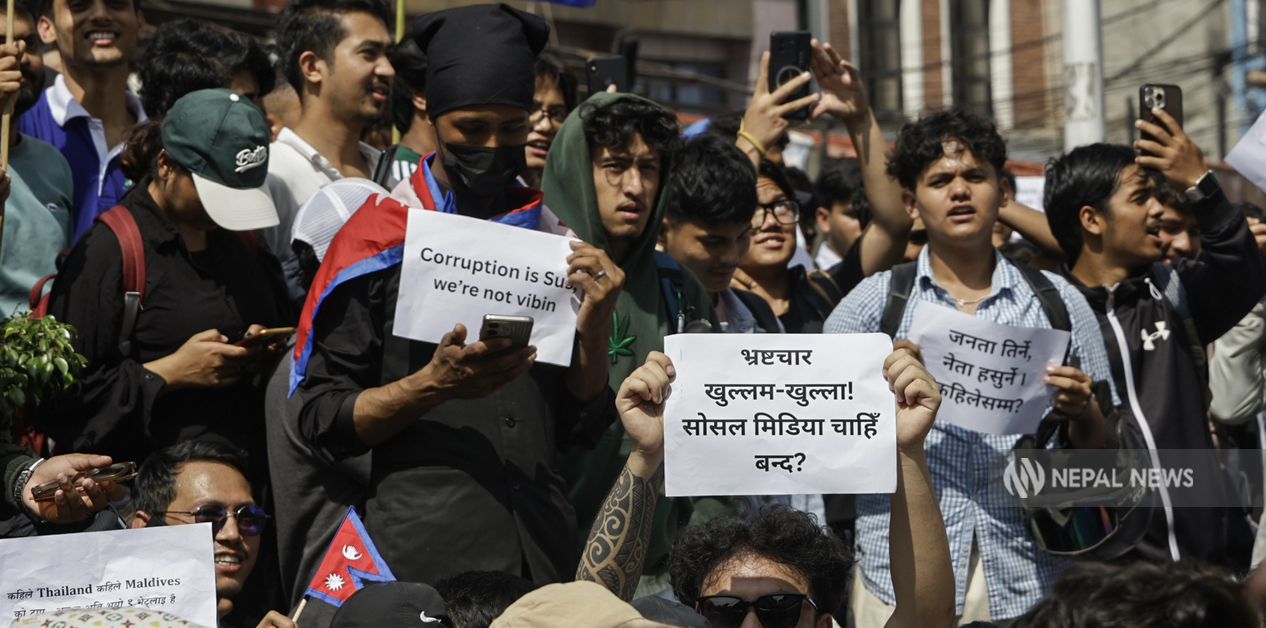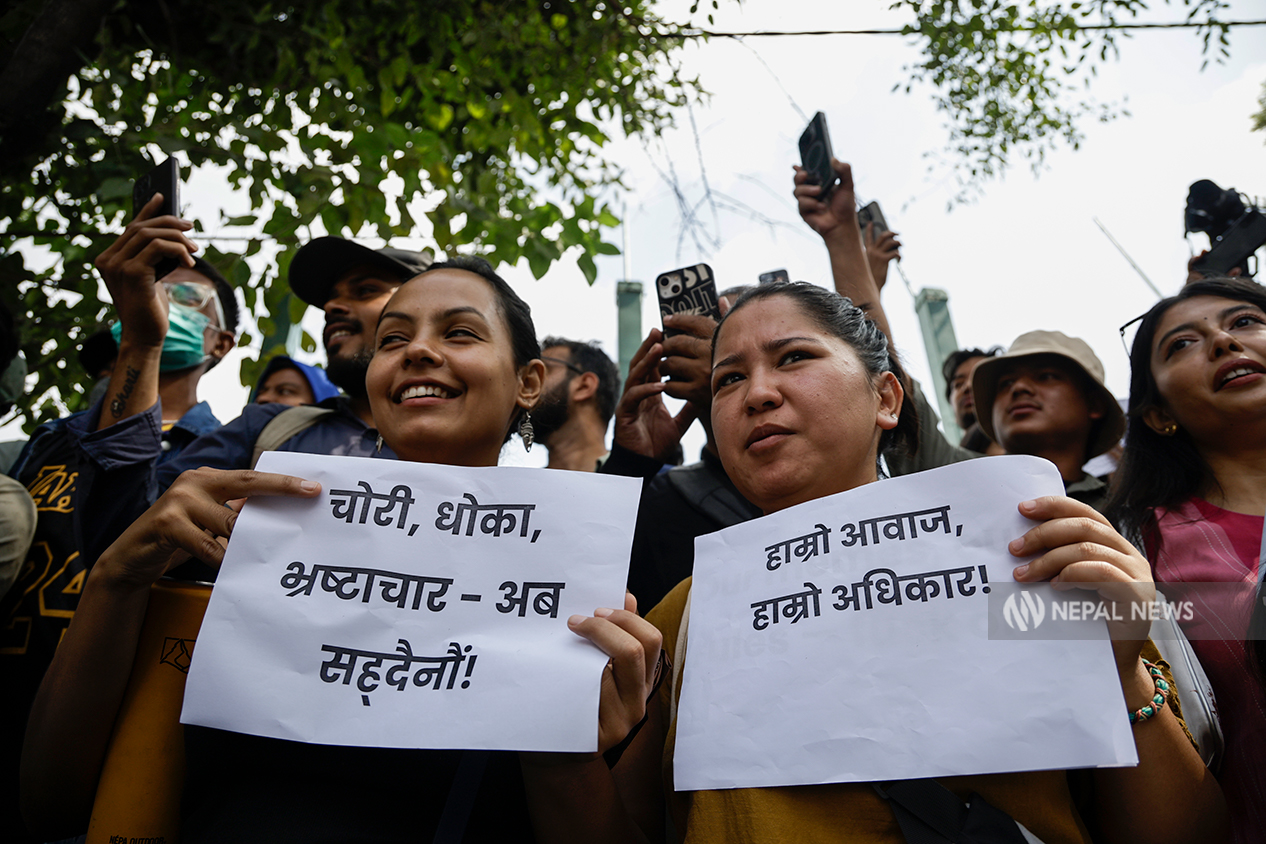
The new generation, rising against three decades of misrule, demands systemic change to pave the way for a prosperous and equitable Nepal

KATHMANDU: The 1990 People’s Movement ended the three-decade-long Panchayat system in Nepal and restored the multi-party democracy. That was a historical moment, which awoke the endless dream of development, prosperity, good governance, and equality in the hearts of the common Nepali. However today, after more than three decades have passed, those dreams have proven to be merely a mirage. The very political leadership that struggled for democracy used the guise of democracy to trap the country in the boundless quagmire of corruption.
Today, at least two such generations have been prepared in Nepal, whose birth took place in the democratic system itself, but whose consciousness and experience are filled with countless instances of corruption, bad governance, and political dishonesty. It has refused to blindly trust the promises made by political parties and their leaders, like its previous generation. And it has sounded the conch of rebellion, which is not merely against a specific person or party but a serious attack against the entire system and the ideological foundation of the old generation that operates it.
At the foundation of this rebellion lies the systemic corruption that flourished over the past three decades, where corruption became not just an individual crime committed by a few people but an integral part of state governance. This not only held back the country’s economic development but also weakened the moral foundation of society and completely destroyed public trust in state institutions.
The poisonous tree nurtured by political protection
If you dig into the roots of every major corruption scandal, it is found to be connected to a center of political power in some form or another. Large-scale corruption is simply not possible here without political protection. The news published in the Nepali media are just a few representative mirrors of those incidents, which show how this poisonous tree of corruption was nurtured.
For instance, some of the main representative incidents of corruption can be taken. First, the Lalita Niwas case and the dangerous practice of ‘policy corruption.’ The registration of more than 143 ropani of government land adjacent to the Prime Minister’s residence in Balwatar under the names of individuals based on forged documents was not a normal incident. This incident brought the concept of ‘policy corruption’ in Nepal to the surface. Decisions made by the Council of Ministers during the tenures of various governments, especially when Madhav Kumar Nepal and Baburam Bhattarai were prime ministers, were used as a basis to open the way for registering government land under the names of individuals. When the Commission for the Investigation of Abuse of Authority (CIAA) initiated an investigation, the political leadership tried to hide behind the shield of the Council of Ministers’ ‘policy decision.’ The Constitution and the law stipulate that the CIAA cannot investigate the policy decisions of the Council of Ministers. This legal loophole was used as a license for corruption. This established that if corruption could be coated with the veneer of a policy decision, the top political leadership would always remain safe.

Gen Z protestors on September 8. Photo: Bikram Rai/Nepal News
Second, the Wide Body aircraft purchase and the helplessness of the parliamentary committee. The fact that there was a scam in the purchase of two wide-body aircraft for the national flag carrier, Nepal Airlines Corporation, was exposed by the Parliament’s Public Account Committee itself. The committee found high-ranking officials, including the then Tourism Ministers Jiwan Bahadur Shahi (Nepali Congress) and Rabindra Adhikari (then Communist Party of Nepal), guilty and recommended action. However, that report and recommendation, claiming four and a half billion in corruption, proved to be merely a show of teeth. The major parties reached a mutual understanding to protect their leaders. The CIAA was also reluctant to investigate the political leadership, and the investigation remained limited to employees. This showed that parliamentary committees have become merely platforms for creating political pressure and transactions, and the executive and constitutional bodies are not obliged to implement their reports.
Third, the Sudan scandal and international disgrace. The Nepal Police has a glorious history in the UN Peacekeeping Mission. However, the scandal that occurred during the purchase of armored personnel carriers (APC) and other materials for the police deployed in Darfur, Sudan, stained that reputation. Corruption took place through collusion with the company that supplied fake and useless materials. In this case, some former police chiefs were found guilty and went to jail, but the political leadership involved in that decision process, especially the then home ministers, always remained outside the scope of investigation. This gave a clear message that in Nepal, the ultimate responsibility for corruption must be borne by the employees, but the political leadership that profits from it and makes it possible always remains untainted.
Fourth, the Fake Bhutanese Refugee scandal and the criminal use of the government’s mechanism. This incident is the most horrifying example of moral decay rather than the economic aspect of corruption. It showed how those in power can use the entire state apparatus as a criminal gang. This organized crime of making Nepali citizens into fake Bhutanese refugees and sending them to America saw the involvement of a former deputy prime minister, a former home minister, an incumbent secretary, and security agency officials. This incident has exposed how deeply rooted criminalization is at the highest level of Nepali politics. The numerous attempts and pressures made to save top leaders during the investigation proved that political parties can go to any extent to protect their leaders.
Apart from these, incidents like giving the contract to the Omni Group for the purchase of health materials during the Covid pandemic crisis, the network of gold smuggling spreading from the palace to the Communist-Congress, and the money meant for Maoist combatants disappearing from the camps themselves, confirm how corruption has become institutionalized under political protection.
The Wide Body aircraft purchase and the helplessness of the parliamentary committee. The fact that there was a scam in the purchase of two wide-body aircraft for the national flag carrier, Nepal Airlines Corporation, was exposed by the Parliament’s Public Account Committee itself.
The erosion of institutions
Corruption does not just empty the nation’s treasury; it weakens and hollows out the pillars of the state itself. Over the past three decades, the credibility of every significant institution in Nepal has seriously deteriorated.
Due to the recent corruption-related incidents, the mistrust towards the judiciary has deepened. It is most unfortunate that the judiciary, the last hope for justice, itself is being accused of corruption and political partisan division. Due to issues ranging from ‘bench-shopping’ to political interference in the appointment of judges, the common citizen’s faith in justice has been broken.
Similarly, the crippling of constitutional bodies is another powerful example of political-social existence decay. The tradition of making appointments in constitutional bodies like the CIAA and the Election Commission based on partisan division did not allow these bodies to remain independent and impartial. The CIAA was portrayed as a ‘paper tiger’ that does not touch the big fish and only catches the small ones, while other bodies became a means to fulfill the interests of the ruling party.
The politicization of the administration became so intense and concentrated that the system of transfer and promotion in the bureaucracy, driven by political loyalty and access instead of merit and capability, rendered the entire administration useless. As a result, employees are forced to be loyal not to the people, but to their political masters.
The clamor for democracy and the silent support of intellectuals
Whenever a voice is raised against corruption and bad governance, the leaders of the old generation start telling stories of their sacrifice and dedication to bring about democracy. They try to justify their remaining in power by saying that democracy and the constitution are ‘in danger.’ But the slogan for the protection of a democracy that cannot give justice, security, and equal opportunities to its citizens becomes hollow. They themselves have used the democracy they fought for as a weapon of corruption to tear it apart, and yet they continue to clamor for it.
The even more tragic aspect of this is the role of the media and the intellectual circle. Some ‘self-proclaimed intellectuals’ who have benefited from power and authority in some way are standing up in defense of those very corrupt individuals, like wolves in sheep’s clothing. They try to dismiss the rebellion by creating conspiracy theories and labeling the new movement as inexperienced. The confusion they have created makes it difficult for the common people to distinguish between right and wrong.
The CIAA was portrayed as a ‘paper tiger’ that does not touch the big fish and only catches the small ones, while other bodies became a means to fulfill the interests of the ruling party.
The path to the future
The crossroad that Nepal stands at today is a collective explosion of the frustration, anger, and betrayal of the past three decades. This is a kind of social surgery, which is extremely painful. It has brought instability to society, but this instability is necessary to root out the tumor of corruption that has become cancer.
What the new generation must understand is that the road ahead is not easy. This path will not be bright and smooth. The old establishment and the benefiting stratum will resist until the very end. But there is no turning back now. This rebellion should not be limited only to changing power and faces. It must open the door to systemic reform. Fundamental reforms such as strengthening anti-corruption laws, ensuring impartial appointments in constitutional bodies, and the practical application rather than just the theory of the rule of law to free politics from crime should be the main agenda now.
The new Nepal that will be formed after this surgery will have deep scars on its body, which will constantly remind us of our dark past. But those scars themselves will be a lesson for the future generation so that they never repeat such mistakes. We have no option now but to move forward, washing off the splashes from walking on a road dirtied by the mud of the past and facing countless challenges. This necessary, albeit painful, path will forge the foundation for a truly prosperous and equitable Nepal.